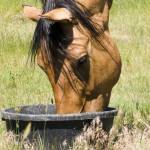Gastric Health of Horses: Effect of Devil’s Claw and Turmeric

More and more owners have sought herbal options as a way to optimize the health of their horses. Two popular supplements, devil’s claw and turmeric, have been used for the treatment of inflammatory symptoms and degenerative disorders for several years. Researchers recently assessed certain gastric health parameters of horses supplemented with these herbs.
In this study, researchers from Louisiana State University chose 12 Thoroughbreds with gastric ulcers noted on gastroscopy.* Horses were assigned to a treatment group, which consumed a devil’s claw/turmeric supplement, or a control group. The supplement was fed for 28 days. Researchers performed gastroscopy on days 0, 14, and 28. Ulcers in the nonglandular and glandular portions of the stomach were counted and severity scored on each of the three days. The pH of the gastric juice was also noted during each gastroscopy.
On the final gastroscopy, researchers found that nonglandular and glandular ulcer scores were significantly lower in both treatment and control horses, indicating the supplement did not worsen gastric ulcers.
This finding was especially interesting because some experts classify devil’s claw as a digestive bitter, an herb that stimulates healthy digestion by increasing gastrointestinal secretions, including gastric acid. Feeding devil’s claw would therefore seem counterintuitive, even harmful, for horses predisposed to gastric ulcers.○ While The Botanical Safety Handbook notes that feeding turmeric is contraindicated for patients with existing gastrointestinal ulceration or hyperacidity, it may protect against the development of ulcers.○
Known also as grapple plant and harpago, devil’s claw (Harpagophytum procumbens) is a ground-trailing, herbaceous perennial native to southern Africa. Stems branch off from a primary tuber that features a deep-growing taproot. Flowers are trumpet-shaped. The woody fruit possesses long, barbed spines, hence the plant’s common names. Extracts are usually taken from roots or secondary tubers, but other plant parts might also be harvested.
Secondary tubers are thought to be the richest source of harpagide, the primary therapeutic constituent in devil’s claw. The plant has been used for its anti-inflammatory, analgesic, antioxidant, digestive, and chondroprotective properties, but specific research of devil’s claw use in horses is scant. In a study conducted in the mid-1990s, mature horses diagnosed with bone spavin, a degenerative arthritis of the hock, were fed an herb mixture that included devil’s claw, blackcurrant, horsetail, and white willow. Researchers found the herb mixture more effective than phenylbutazone, known commonly as bute, for ameliorating pain after 120 days of supplementation.+
Turmeric (Curcuma longa L.), referred to as Indian saffron or yellow ginger, is cultivated in parts of China, India, Africa, Thailand, and throughout the tropics. A perennial herbaceous plant, turmeric features yellowish-orange rhizomes, which are stems that run horizontally underground. Turmeric imparts a mustard-like, earthy aroma and pungent, slightly bitter flavor to foods. Like devil’s claw, turmeric purportedly has anti-inflammatory and antioxidant properties, as well as anti-clotting mechanisms.
A horse’s health care team can determine collectively if a supplement would be appropriate for a horse, given its age, use, and health concerns. All nutritional supplements should be backed by high-quality research. For gastric health, choose a research-proven, effective supplement.
Keep in mind that many herbal preparations are prohibited in equestrian sports sanctioned by national and international federations, so check with the governing body of any sport before feeding an herbal supplement.
*St. Blanc, M., H. Banse, M. Retif, N. Arana-Valencia, M.L. Keowen, F. Garza, C. Liu, L. Gray, and F. Andrews. 2020. Effects of supplements containing turmeric and devil’s claw on equine gastric ulcer scores and gastric juice pH. In: Proceedings American Association of Equine Practitioners 66:86.
○Wynn, S.G., and B.J. Fougére. 2007. Veterinary herbal medicine. Mosby. St. Louis, MO. p. 535-536.
+Montavon, S. 1994. Efficacy of a phytotherapeutic preparation based on Harpagophytum procumbens in case of bone spavin of adult horses. Prac. Vet. Equine 26:49-53.








